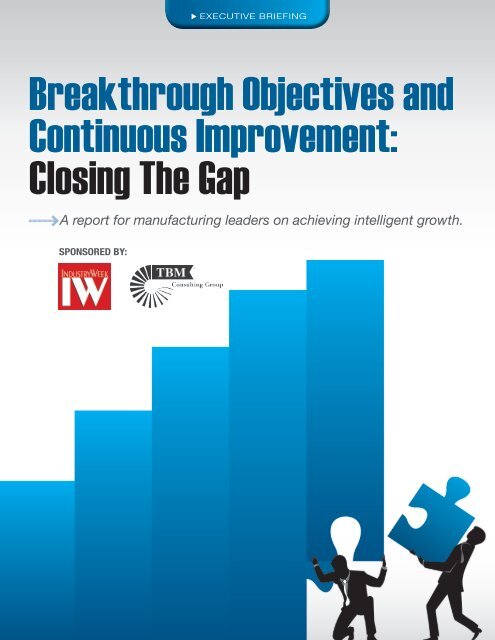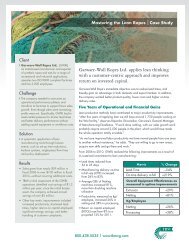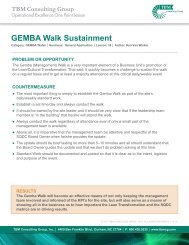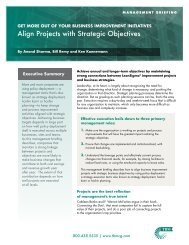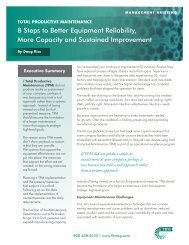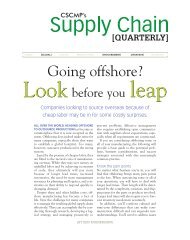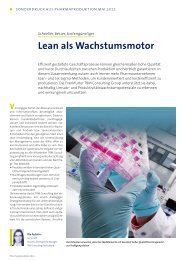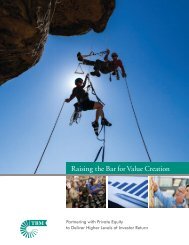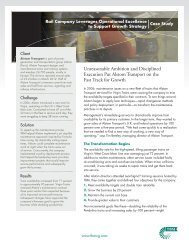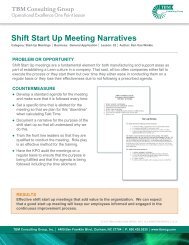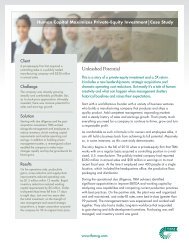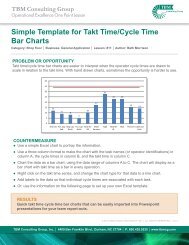Breakthrough Objectives and Continuous Improvement: Closing The ...
Breakthrough Objectives and Continuous Improvement: Closing The ...
Breakthrough Objectives and Continuous Improvement: Closing The ...
You also want an ePaper? Increase the reach of your titles
YUMPU automatically turns print PDFs into web optimized ePapers that Google loves.
Executive Briefing<br />
<strong>Breakthrough</strong> <strong>Objectives</strong> <strong>and</strong><br />
<strong>Continuous</strong> <strong>Improvement</strong>:<br />
<strong>Closing</strong> <strong>The</strong> Gap<br />
A report for manufacturing leaders on achieving intelligent growth.<br />
Sponsored by:
2 www.tbmcg.com I www.industryweek.com
Table of Contents<br />
About This Report* 3<br />
Introduction: Conceptions,<br />
Misconceptions <strong>and</strong> Realities 4<br />
Key Metrics: CI Companies Are Growth Leaders 6<br />
<strong>Closing</strong> the Gaps: Increasing the Benefits of CI 8<br />
Revenue Growth: Alignment, Execution<br />
<strong>and</strong> <strong>Breakthrough</strong> 9<br />
Customer Intimacy: CI Driving Forward-<br />
Focused Planning 10<br />
Assessing CI Effectiveness 11<br />
*Percentages don’t always add to 100 due to rounding.<br />
About This Report<br />
<br />
This report presents the results<br />
of an exclusive survey of select<br />
IndustryWeek readers conducted<br />
by Penton Research for IW Custom<br />
Research <strong>and</strong> TBM Consulting<br />
Group. <strong>The</strong> research objectives<br />
were to determine the benefits<br />
received from using operational<br />
excellence/continuous-improvement<br />
programs <strong>and</strong> to identify gaps<br />
between program outcomes <strong>and</strong><br />
strategic goals.<br />
Penton Research emailed invitations<br />
to participate in the online survey to<br />
a net 38,324 subscribers. By Nov. 8,<br />
2011, Penton Research received 300<br />
completed surveys, for an effective<br />
response rate of 0.8 percent.<br />
About IW Custom Research<br />
<br />
IW Custom Research is an operating<br />
unit of IndustryWeek magazine that<br />
provides insight into executives’<br />
opinions <strong>and</strong> manufacturing trends.<br />
IndustryWeek connects decisionmakers<br />
within manufacturing<br />
enterprises to share ideas <strong>and</strong> tools<br />
that inspire action. In print, online<br />
<strong>and</strong> in person, the IndustryWeek<br />
community is the leading resource<br />
for manufacturing operations<br />
knowledge. IndustryWeek is a<br />
property of Penton Media Inc.<br />
For more information, go to<br />
www.industryweek.com.<br />
About TBM Consulting Group<br />
<br />
TBM Consulting Group is a global<br />
operations management consultancy<br />
helping manufacturing <strong>and</strong> service<br />
organizations leverage business<br />
excellence for significant competitive<br />
advantage <strong>and</strong> value creation. <strong>The</strong><br />
company was pivotal in introducing<br />
LeanSigma management principles<br />
to the North American market 20<br />
years ago. TBM consultants are<br />
frequently retained for their ability<br />
to help organizations execute <strong>and</strong><br />
achieve breakthrough results <strong>and</strong><br />
for leaving behind a framework <strong>and</strong><br />
structure for sustainment. TBM cofounder<br />
<strong>and</strong> CEO An<strong>and</strong> Sharma<br />
has co-written two books, “<strong>The</strong><br />
Perfect Engine: How to Win in the<br />
New Dem<strong>and</strong> Economy by Building<br />
to Order with Fewer Resources” <strong>and</strong><br />
“<strong>The</strong> Antidote, How to Transform<br />
Your Business for the Extreme<br />
Challenges of the 21st Century.”<br />
TBM developed Dploy Solutions<br />
(www.dploysolutions.com), a suite<br />
of web-based SaaS products that<br />
facilitate management processes<br />
for effectively executing strategic<br />
objectives, tracking key performance<br />
indicators, managing a knowledge<br />
base <strong>and</strong> for aligning continuous<br />
improvement initiatives with critical<br />
business performance metrics. For<br />
more information call 800.438.5535<br />
or visit www.tbmcg.com.<br />
www.industryweek.com I www.tbmcg.com 3
Introduction<br />
Conceptions, Misconceptions <strong>and</strong> Realities<br />
In fall of 2011, IndustryWeek <strong>and</strong> TBM Consulting<br />
Group collaborated to identify conceptions,<br />
misconceptions <strong>and</strong> realities about the connection<br />
between continuous improvement (CI) programs <strong>and</strong><br />
high-level strategic goals that achieve “breakthrough”<br />
(i.e., transformative) change <strong>and</strong> intelligent growth at<br />
global manufacturing enterprises.<br />
This collaboration resulted in the following<br />
conclusions:<br />
Companies with CI programs are much more<br />
successful at increasing revenues, operating<br />
income <strong>and</strong> cash flow.<br />
<strong>The</strong> ability to grow increases as a company’s<br />
CI program matures.<br />
To get more from their CI programs, leaders<br />
should improve communications, speed up<br />
problem solving, <strong>and</strong> have a better underst<strong>and</strong>ing<br />
of customer dem<strong>and</strong>.<br />
CI companies are more likely to use forwardlooking<br />
planning tools than non-CI companies.<br />
While manufacturers have been using CI<br />
programs (i.e., Toyota Production System, lean<br />
management, operational excellence, LeanSigma) for<br />
decades to improve productivity <strong>and</strong> remove costs,<br />
many — we suspected — were not fully optimizing<br />
their CI efforts for growth. We also theorized that<br />
organizations with a focus on business excellence<br />
create more value than those without such a focus.<br />
<strong>The</strong>se two theories became the basis for an<br />
IndustryWeek reader survey of C-level executives,<br />
vice presidents/directors, <strong>and</strong> managers (Figure 1)<br />
at public <strong>and</strong> private companies (Figure 2) across<br />
a variety of manufacturing sectors, the largest of<br />
which were industrial machinery, aerospace/defense,<br />
medical devices, food <strong>and</strong> beverage, automotive, <strong>and</strong><br />
consumer durables. Companies ranged in size from<br />
less than $100 million to more than $5 billion.<br />
TBM Outlook<br />
Companies need to grow, but executives have<br />
learned that growth without transformative<br />
change is fleeting. As companies grow, they also<br />
become more complex, <strong>and</strong> if this complexity<br />
is not managed through ongoing continuous<br />
improvement/operational excellence efforts, the<br />
benefits of growth erode.<br />
Intelligent Growth:<br />
Occurs with “attention” to cost but not<br />
a focus solely on cost.<br />
Is driven by processes that achieve<br />
intimacy with customers.<br />
Requires an enterprise-wide<br />
culture change.<br />
Challenges leaders to be open to<br />
looking at business structure<br />
in new ways.<br />
Source: TBM Consulting Group<br />
We gathered baseline information on executive<br />
priorities <strong>and</strong> the number of companies that use CI<br />
programs. Although responses regarding executive<br />
priorities were as expected, we were surprised<br />
<strong>and</strong> pleased to see that 84 percent of responding<br />
companies have CI programs of varying maturity<br />
(Figure 3).<br />
We also asked all respondents what they believe<br />
are the most important priorities for their executives,<br />
regardless of CI program maturity level (Figure 4).<br />
Revenue growth <strong>and</strong> cash flow were key priorities<br />
for all respondents. In the sections that follow, we<br />
describe what we learned by presenting research<br />
results, interpreting <strong>and</strong> elaborating on the results<br />
based on our shared knowledge <strong>and</strong> experience,<br />
<strong>and</strong> incorporating real-world examples of companies<br />
that have successfully used CI not only for internal<br />
improvement, but for intelligent growth.<br />
4 www.tbmcg.com I www.industryweek.com
Figure 1: Respondent Job Level<br />
12%<br />
17%<br />
16%<br />
31%<br />
24%<br />
■ C-Level<br />
■ VP/Director<br />
Figure 2: Company Ownership<br />
Owned by<br />
private<br />
equity<br />
10%<br />
Privately<br />
held<br />
50%<br />
Publicly<br />
traded<br />
40%<br />
■ Manager with Direct Reports<br />
■ Manager without Direct Reports<br />
■ Other<br />
Figure 3: CI Maturity Level<br />
How would you describe your company’s operational excellence/continuous improvement programs?<br />
Mature: <strong>Continuous</strong> improvement is the basis<br />
of our company-wide culture <strong>and</strong> strategy.<br />
26%<br />
Moderate: We are in the process of or have<br />
implemented strategy deployment <strong>and</strong>/or are<br />
working extensively with suppliers.<br />
Midcourse: We are starting to apply<br />
operational excellence principles/programs to<br />
non-production functions such as sales,<br />
marketing, IT, finance, etc.<br />
Early: We have started using tools such<br />
as kaizen, one-piece flow, st<strong>and</strong>ard work, etc.<br />
22%<br />
23%<br />
26%<br />
other/No reply. 2%<br />
Figure 4: Executive Priorities<br />
Which of these will be priorities for executives at your company during the next 12 months?<br />
■ First choice ■ Second choice ■ Third choice ■ Fourth choice ■ Fifth choice<br />
revenue growth 25% 10% 9% 6% 8%<br />
Improving cash flow 17% 13% 9% 6% 5%<br />
Containing direct costs 8% 9% 12% 11% 10%<br />
New-product innovation 8% 8% 7% 4% 10%<br />
Improving productivity 7% 13% 15% 15% 8%<br />
www.industryweek.com I www.tbmcg.com 5
Key Metrics<br />
CI Companies Are Growth Leaders<br />
<strong>The</strong> first area we studied was metrics — specifically<br />
growth of revenue, operating income <strong>and</strong> cash<br />
flow because these are the building materials of<br />
transformative change <strong>and</strong> intelligent growth. Not<br />
surprisingly, companies with CI programs fared better<br />
than companies with no CI programs (Figure 5). What<br />
we learned, though, is that this difference is dramatic.<br />
Additionally, as CI programs mature, growth margins<br />
increase (Figures 6, 7 <strong>and</strong> 8).<br />
Figure 5 clearly demonstrates that companies with<br />
no CI program expect little or no revenue growth, flat<br />
or declining operating income, <strong>and</strong> flat or negative<br />
Figure 5 : CI Companies Perform Better<br />
Midcourse or Mature<br />
<br />
No Program<br />
➤ 50%+ expect revenue growth<br />
5.1% or higher<br />
➤ 61% expect operating income<br />
growth 5.1% or higher<br />
➤ 54% expect cash flow to increase<br />
➤ 50%+ expect revenue growth<br />
3% or less<br />
➤ 49% expect operating income<br />
growth to be flat or down<br />
➤ 79% expect cash flow to be about<br />
the same or down<br />
changes in cash flow. On the flip side, over 50 percent<br />
of Midcourse/Mature CI organizations expect revenue<br />
growth of 5 percent or higher, operating income of<br />
5 percent or higher, <strong>and</strong> increased cash flow.<br />
align CI program activities to financial objectives to<br />
ensure that the activities yield results that will create the<br />
most value for the enterprise.<br />
Mature CI companies have placed a heavier emphasis<br />
on business process to drive growth, applying<br />
continuous improvement to sales force effectiveness,<br />
speed to market, rapid product commercialization <strong>and</strong><br />
other non-manufacturing areas of the value stream.<br />
Furthermore, as these organizations reduce working<br />
capital <strong>and</strong> generate improved free cash flow, they are<br />
leveraging the liberated resources, their management<br />
system <strong>and</strong> their improved ability to execute<br />
strategically; acquire new businesses for growth;<br />
integrate acquisitions quickly; better serve customers;<br />
<strong>and</strong> capture market share from competitors.<br />
As with revenue growth, operating income growth will<br />
be greater for companies with CI programs in 2012,<br />
<strong>and</strong> those with Mature programs expect the largest<br />
gains (Figure 7).<br />
Fifty-four percent of Mature organizations expect<br />
an increase in cash flow (Figure 8). Early/Midcourse<br />
varies based on where they are in the process. Still, 45<br />
percent of respondents at the Midcourse level expect<br />
cash flow to increase, while most of the companies<br />
with no program expect cash flow to stay the same (45<br />
percent) or decrease (34 percent).<br />
Reductions in working capital enable organizations to<br />
reduce reliance on short- <strong>and</strong> long-term debt, invest for<br />
growth, <strong>and</strong> avoid having large amounts of cash tied up<br />
in obsolete or excess inventory.<br />
Why is all of this so important to breakthrough<br />
transformation? Consider the following examples.<br />
This supports the TBM concept of intelligent growth:<br />
We believe there is a significant opportunity to better<br />
6 www.tbmcg.com I www.industryweek.com
Figure 6: Expected Revenue Growth<br />
100%<br />
90%<br />
80%<br />
70%<br />
60%<br />
50%<br />
40%<br />
30%<br />
20%<br />
10%<br />
0%<br />
Figure 7: Expected Operating Income Growth<br />
100%<br />
90%<br />
80%<br />
70%<br />
60%<br />
50%<br />
40%<br />
30%<br />
20%<br />
10%<br />
0%<br />
Figure 8: Reported Change in Cash Flow over the Past Year<br />
100%<br />
90%<br />
80%<br />
70%<br />
60%<br />
50%<br />
40%<br />
30%<br />
20%<br />
10%<br />
0%<br />
15.1% +<br />
5.1% – 15%<br />
3.1% – 5%<br />
3% or less<br />
Mature Early/Midcourse No Program<br />
15.1% + 15.1% +<br />
5.1% – 15%<br />
3.1% – 5%<br />
3% or less<br />
Mature Early/Midcourse No Program<br />
Increased<br />
About the Same<br />
Decreased<br />
15.1% + 15.1% +<br />
5.1% – 15%<br />
3.1% – 5%<br />
3% or less<br />
5.1% – 15%<br />
3.1% – 5%<br />
3% or less<br />
Increased<br />
About the Same<br />
Decreased<br />
5.1% – 15%<br />
3.1% – 5%<br />
3% or less<br />
Companies with no CI program growing slower.<br />
15.1% +<br />
5.1% – 15%<br />
3.1% – 5%<br />
3% or less<br />
Companies with no CI program have slower bottomline growth.<br />
Increased<br />
About the Same<br />
Decreased<br />
Mature Early/Midcourse No Program<br />
CI programs put more cash in pockets.<br />
Milbank Frees Up Cash To Grow:<br />
Milbank Manufacturing Company liberated<br />
cash <strong>and</strong> space using lean process improvement,<br />
<strong>and</strong> subsequently was able to pursue a<br />
differentiated growth strategy. Milbank plays<br />
in a very mature category of electric meter<br />
sockets <strong>and</strong> needed to enter new markets for<br />
continued growth <strong>and</strong> profitability.<br />
<strong>The</strong> leadership team defined a vision <strong>and</strong><br />
drove that vision throughout the organization<br />
by embracing operational excellence to rapidly<br />
drive sustainable improvements in quality,<br />
cost <strong>and</strong> delivery. <strong>The</strong>y are now using the<br />
freed-up cash <strong>and</strong> space to invest in a new<br />
alternative-energy solutions business.<br />
Milbank reduced lead times by 53 percent<br />
<strong>and</strong> generated over $3.5 million from reductions<br />
in work-in-process <strong>and</strong> finished goods<br />
inventory. <strong>The</strong>y were able to support their<br />
growth initiative with existing facilities by liberating<br />
100,000 square feet of floor space.<br />
Improved Agility Beats<br />
Low-Cost Competition:<br />
One of the outcomes of lean continuous<br />
improvement is faster responsiveness <strong>and</strong><br />
increased agility. <strong>The</strong>se attributes enabled<br />
WIKA, a leading international manufacturer of<br />
pressure gauges <strong>and</strong> other critical measurement<br />
instruments, to respond quickly to market<br />
declines <strong>and</strong> grow significantly — even<br />
during a global economic recession. WIKA<br />
transformed from a high-volume, low-mix<br />
producer to a low-volume, high-mix producer<br />
in order to compete with low-cost competitors<br />
abroad. By doing so, the company<br />
doubled revenue in eight years. Profitability<br />
grew by more than 10 times during the same<br />
period. Market-based growth, operational<br />
dexterity, superb execution, <strong>and</strong> committed<br />
associates were behind the success.<br />
www.industryweek.com I www.tbmcg.com 7
<strong>Closing</strong> the Gaps<br />
Increasing the Benefits of CI<br />
When CI initiatives are properly aligned to strategic<br />
objectives <strong>and</strong> key performance indicators (KPIs),<br />
it becomes easier to ensure that associates clearly<br />
underst<strong>and</strong> the organization’s challenges. This<br />
is why CI should be a foundational element of a<br />
comprehensive business system. Following are three<br />
examples of how leaders can do this while addressing<br />
the improvement opportunities listed in Figure 9.<br />
Communication: Policy deployment helps leaders<br />
to create a detailed action plan for achieving strategic<br />
objectives; agree on KPIs; <strong>and</strong> assign individual<br />
responsibility. It also establishes a process <strong>and</strong><br />
disciplined set of checks for monitoring projects<br />
<strong>and</strong> progress.<br />
<strong>The</strong> mistake that leadership teams often make without<br />
policy deployment is to take a lot of time discussing<br />
a five-year strategic plan <strong>and</strong> vision without defining<br />
the details of how to execute. <strong>The</strong> policy deployment<br />
process brings leaders to agreement on three to five key<br />
breakthrough processes that they will collectively work<br />
on <strong>and</strong> support during the next year.<br />
Problem Solving: Monthly reviews for both policy<br />
deployment <strong>and</strong> KPIs help leaders to quickly address<br />
initiatives that are falling behind on objectives. As a<br />
result, managers can drill down to better underst<strong>and</strong><br />
root cause for the miss <strong>and</strong> ensure that the<br />
countermeasures put into place will correct the problem.<br />
Customer Dem<strong>and</strong>: Companies that have<br />
consistently outperformed the S&P 500 put the<br />
customer at the center of all their decisions. <strong>The</strong>y<br />
embrace capabilities such as voice of the customer,<br />
value selling, cooperative business planning, customer<br />
segmentation <strong>and</strong> product commercialization to ensure<br />
a better underst<strong>and</strong>ing of customer dem<strong>and</strong>.<br />
Figure 9: Upping Benefits From CI<br />
Which of these would most increase the benefits your company receives from its operational excellence/<br />
continuous improvement effort?<br />
■ First choice ■ Second choice ■ Third choice ■ Fourth choice ■ Fifth choice<br />
better communication <strong>and</strong><br />
planning among functions.<br />
Faster problem solving.<br />
A more concrete underst<strong>and</strong>ing<br />
of customer dem<strong>and</strong>.<br />
27% 12% 11% 11% 12%<br />
14% 19% 14% 11% 5%<br />
12% 11% 10% 6% 10%<br />
Better enterprise-wide underst<strong>and</strong>ing <strong>and</strong><br />
analysis of process <strong>and</strong> performance data.<br />
11% 16% 10% 12% 8%<br />
Faster new-product development. 9% 6% 8% 8% 10%<br />
Faster adjustment to changing<br />
customer dem<strong>and</strong>.<br />
8% 13% 11% 7% 11%<br />
A long-term performance focus vs. quarterly. 7% 8% 8% 5% 8%<br />
more/better operator training. 3% 5% 8% 11% 8%<br />
8 www.tbmcg.com I www.industryweek.com
Revenue Growth<br />
Alignment, Execution <strong>and</strong> <strong>Breakthrough</strong><br />
When we asked respondents what they should do<br />
to increase their company’s ability to grow revenue,<br />
their top choices were (Figure 10):<br />
Improve ability <strong>and</strong> speed to introduce<br />
differentiated products.<br />
Improve ability to more quickly <strong>and</strong> efficiently<br />
close sales.<br />
Streamline product or service portfolio to<br />
optimize sales <strong>and</strong> profit potential.<br />
TBM Outlook<br />
We are seeing that companies that are applying<br />
process control <strong>and</strong> CI practices to address<br />
challenges in functional areas, such as sales,<br />
product management, <strong>and</strong> change management, are<br />
emerging as leading competitors in their industries<br />
despite escalating competition.<br />
Here again, organizational alignment via a business<br />
plan rooted in CI is key to achieving these improvements.<br />
One example of a company that has successfully<br />
done this is Trail King Industries, a manufacturer<br />
of customized trailers used for transporting<br />
heavy equipment <strong>and</strong> other oversized items.<br />
Trail King needed to augment sales <strong>and</strong> improve<br />
cash flow. Company leaders agreed a key breakthrough<br />
objective was elimination of bottlenecks in<br />
the new-product-development process in order to<br />
get new designs <strong>and</strong> customized products to customers<br />
quicker. <strong>The</strong>y embraced a LeanSigma design<br />
process that introduced early collaborative planning<br />
to prevent downstream disruptions in the design<br />
process. As a result, Trail King reduced the design<br />
phase of the customization process by 12 weeks,<br />
cut production costs, <strong>and</strong> increased quality <strong>and</strong> customization<br />
options. Before this breakthrough, product<br />
development from concept to rollout took one<strong>and</strong>-a-half<br />
to two years. Afterwards — nine months.<br />
Figure 10: Getting Better At Revenue Growth<br />
Which of these would most increase your company’s ability to grow revenue?<br />
■ First choice ■ Second choice ■ Third choice ■ Fourth choice ■ Fifth choice<br />
Improving the new-product-development process to<br />
more quickly <strong>and</strong> efficiently fulfull unmet customer needs.<br />
25% 19% 13% 8% 9%<br />
Improving sales <strong>and</strong> processes to more quickly<br />
<strong>and</strong> efficiently close sales.<br />
22% 10% 11% 9% 9%<br />
rationalizing products/product families to concentrate<br />
on those with the greatest sales/profit potential.<br />
17% 15% 13% 14% 11%<br />
becoming a more flexible supplier to<br />
meet variable customer dem<strong>and</strong>.<br />
13% 17% 13% 11% 9%<br />
Improving both horizontal <strong>and</strong> vertical<br />
alignment around strategic goals.<br />
8% 10% 13% 10% 6%<br />
better supplier performance. 5% 12% 10% 17% 14%<br />
www.industryweek.com I www.tbmcg.com 9
Customer Intimacy<br />
CI Driving Forward-Focused Planning<br />
Because planning is so crucial to performance,<br />
we wanted to find out what tools companies<br />
used for planning.<br />
TBM Outlook<br />
While “looking-back” sales <strong>and</strong> profitability data has<br />
its place in planning, it is not as effective at providing<br />
guidance on what to do today to be successful tomorrow.<br />
<strong>The</strong> challenge for leaders is to apply CI tools to get closer<br />
to customers <strong>and</strong> better underst<strong>and</strong> markets.<br />
We found evidence that Mature CI companies are<br />
making progress toward using more “real-time”<br />
market indicators such as market-focused business<br />
Figure 11: Too Much Looking Back, Not Enough<br />
Looking Ahead<br />
Mature CI Program<br />
LOOKING AHEAD<br />
➤ 70% using competitive<br />
analysis<br />
➤ 68% using market-focused<br />
business analytics<br />
➤ 54% using information<br />
about forward-looking<br />
customer strategies<br />
No CI Program<br />
LOOKING BACK<br />
➤ 36% using competitive<br />
analysis<br />
➤ 21% using marketfocused<br />
business analytics<br />
➤ 28% using information<br />
about forward-looking<br />
customer strategies<br />
analytics <strong>and</strong> information on forward-looking<br />
customer strategies (Figure 11). One such company<br />
is Vermeer, which picked up on subtle differences in<br />
customer preferences for its products though voiceof-the-customer<br />
research.<br />
Customer Insight Prompts Targeted Design:<br />
Vermeer, a global producer of heavy equipment for<br />
construction <strong>and</strong> agriculture, used the CI principle<br />
of voice of customer to identify a potential misstep<br />
that could have occurred when it began selling a<br />
new trenching machine in China. <strong>The</strong> machine had<br />
been designed to deliver labor savings, which is<br />
highly valued by Vermeer’s U.S. customers. In China,<br />
however, labor savings is less important while other<br />
attributes are more valued. Vermeer learned this by<br />
taking a custom-focused, forward-looking planning<br />
strategy <strong>and</strong> subsequently created a modified design<br />
for the Chinese market.<br />
Vermeer’s story illustrates the urgent need for<br />
manufacturers to apply process excellence in all<br />
elements of the value stream. <strong>The</strong> company decided<br />
not to sell current products overseas but instead opted<br />
to delve deeply into the minds of their customers.<br />
Growth in a global economy is becoming more difficult<br />
to achieve. Manufacturers will need to transform in<br />
order to stay competitive. If Vermeer had introduced<br />
a product developed for the American market, for<br />
example, it would not be as successful in China.<br />
10 www.tbmcg.com I www.industryweek.com
Looking Forward<br />
<strong>Closing</strong> the Gaps<br />
Assessing CI Effectiveness<br />
Success such as that achieved by Vermeer requires<br />
a leadership-supported connection between CI<br />
priorities <strong>and</strong> strategic priorities. Vermeer is a Mature<br />
CI company (practicing for more than 10 years) <strong>and</strong><br />
uses strategy-deployment <strong>and</strong> an ongoing cycle of CI<br />
projects to intelligently grow.<br />
One of the hallmarks of a company operating at this<br />
mature level is that CI practices <strong>and</strong> tools are both<br />
customer-centric <strong>and</strong> process-centric:<br />
If your company has been practicing CI for a number<br />
of years <strong>and</strong> has not achieved the corresponding<br />
growth depicted, this could be because of a gap<br />
between your CI priorities <strong>and</strong> your strategic priorities.<br />
As this report demonstrates, closing this gap is a<br />
worthy effort for global manufacturing leaders because<br />
as alignment improves, CI learning <strong>and</strong> application<br />
mature, which opens the door for transformative<br />
change <strong>and</strong> lasting growth.<br />
Customer Centric<br />
Accessing the customer mind-set<br />
Organizing around value streams<br />
Process Centric<br />
Converting ideas to innovation<br />
Product commercialization<br />
Strategy execution<br />
Talent development<br />
<strong>The</strong> case studies we presented illustrate some of<br />
the promising opportunities that are waiting to be<br />
discovered. In order for leaders to realize these<br />
opportunities, though, they will need to change their<br />
thinking on CI programs as our case-study companies<br />
did. This will mean being open to entirely new business<br />
structures, but the resulting benefits will enable leaders<br />
to differentiate their companies in the increasingly<br />
crowded global marketplace.<br />
Cooperative business<br />
planning<br />
Operational excellence<br />
Figure 12: CI Progression<br />
Business performance<br />
metrics<br />
Acquisition integration<br />
Outcomes of such a<br />
strategy are speed to market,<br />
product vitality, free cash flow,<br />
consistent earnings growth,<br />
<strong>and</strong> a sustainable competitive<br />
advantage.<br />
Where is your company<br />
on TBM’s lean-progression<br />
matrix (Figure 12)?<br />
www.industryweek.com I www.tbmcg.com 11


